With a tight fit at the waist and flared from the hip line A-line skirt appeared in the mid-50s of the last century and still remains a popular model among modern fashionistas. It is easy to sew your favorite skirt with your own hands. A master class on making a pattern and sewing a skirt will help you stay in the fresh trend and significantly update your women's wardrobe.
Who is this style suitable for?
The peculiarity of the skirt shape is the visual reduction of the waist, hips and lengthening of the legs. These undoubted advantages make the model especially attractive for women of different ages and body types. "Trapeze" suits young and slender girls with a model figure and persons in the Plus size category.
The A-line skirt looks equally good on tall and thin girls in the mini version and on short, curvy women in the midi and maxi versions.

Recommendations for women of different body types and age groups:
- For young and slender girls, the skirt can be "mini" or "midi". The product can be tight-fitting at the waist, as well as with folds or gathers at the waist and hips. The "maxi" option is not recommended for everyday wear and is suitable only for special occasions.
- For women with an hourglass figure, as well as for curvy shapes with the right proportions (the "Rubens" type), trapezoid skirts with a length to the knee line or slightly below it are suitable. The style of the skirts should not be overloaded with excess volume in the hip area, infrequent vertical folds or "wrap" are recommended.
- For women of short stature with a lower body type (pear), the ideal solution would be a trapeze skirt with a tight waist without yokes and horizontal undercuts. Additional volume in the hip area in the form of gathers and folds should be excluded. The optimal skirt length for this category of women is just above the knee, to the middle of the knee, the "French" length.
In order not to violate the correct proportions, the length of the A-line skirt should visually be greater than the width of the hips. The A-line skirt is a universal item of women's wardrobe, it can be combined with almost any top, from simple cotton T-shirts to jackets, short coats and short fur coats.
This ideal waistband goes well with blouses, T-shirts, turtlenecks or warm sweaters. The main thing is that such a combination is correct in style, color and shape.
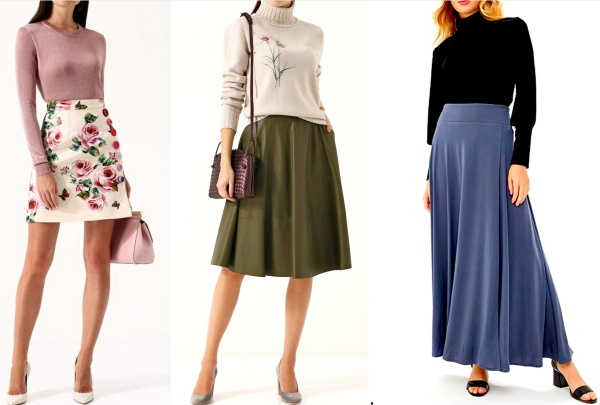
Shoes for a trapeze skirt are selected depending on its length and the specific occasion. For example, high-heeled shoes are suitable for creating an image with a short skirt, and for a maxi skirt, a combination with shoes without a heel or a solid sole - sandals, ballet flats, light summer flip-flops, Roman shoes or clogs - will be very organic.
Taking measurements and calculating fabric
Sewing a skirt begins with choosing a style, taking measurements and calculating the material.
Measuring your figure
The pattern for an A-line skirt is made using a straight skirt design, for which the following measurements are needed:
| Conventional name | Transcript |
| St | half waist |
| Sat | semi-hip circumference |
| Vb | hip height |
| Di | length of product |
To create a skirt design with an offset waist, additional measurements are taken - a new waist line is marked on the figure with a visual horizontal line (optional) and measurements are taken using this reference point.
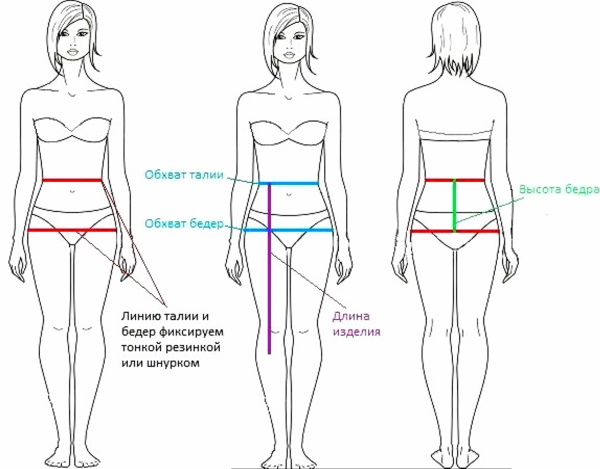
In addition to absolute measurements, to construct a design drawing, allowances for ease of fit at the waist (Pt) and hip area (Pb) will be needed. These values are constant and change only in connection with fashion trends in clothing design.
Fabric calculation
To calculate the fabric for a skirt, two measurements are taken - the length of the product and the hip circumference. Measuring the half-girth of the hips (Sb) is necessary to calculate whether the finished patterns of the skirt will fit with a certain width of fabric. The length of the skirt (Di) is necessary to calculate the required consumption of a piece of material for the shaped length of the skirt, taking into account all the cutout details with allowances, with a reserve of fabric for the spreading of the patterns.
Approximate calculation of fabric with a fabric width of 150.0 cm for a "Trapeze" skirt for a figure with a hip volume of 120.0 cm:
Estimated length of the piece = 90.0 cm (Di in g/v) + 15.0 cm (waistband with allowance) + 4.0 cm (hem hem) + 10.0-20.0 cm (reserve for other allowances and pattern spreading) = 120.0-125.0 cm.
In addition, when calculating the material, you need to take into account the direction of the warp thread (with a bias cut, a completely different calculation method), the direction of the pattern (checkered, striped or coupon) and the width of the material. For example, with a fabric width of 110.0-130.0 cm, the calculated length of the piece is increased by 2 times.
The basis of the pattern
To construct a skirt of any style, including the "Trapeze", the design of a classic straight skirt is used.
On this basic basis, through modeling, you can sew a large number of different models:
- pencil skirt;
- skirt with buttons (fastening);
- balloon skirt, tulip skirt;
- wrap skirt;
- a skirt with pleats and yokes.
Step-by-step execution of the base structure:
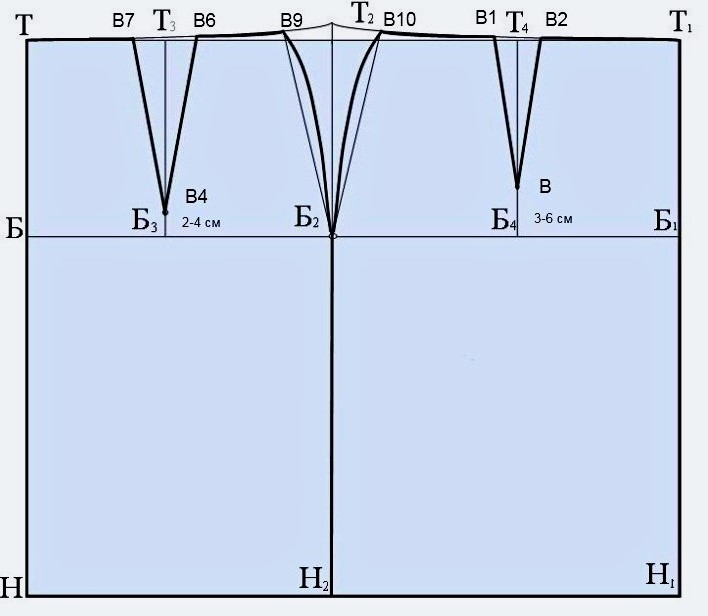
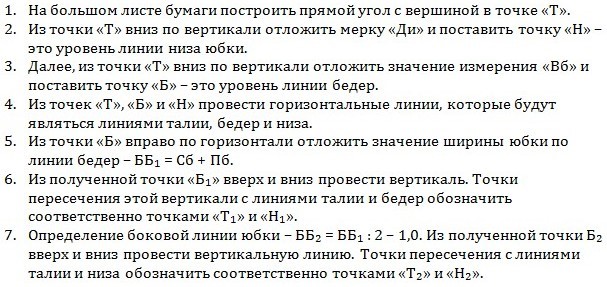
Note: Raise point "T₂" vertically by 1.0-2.0 cm. This is the difference between the length of the skirt from the floor in the middle of the front and the length of the skirt from the floor along the side seam.
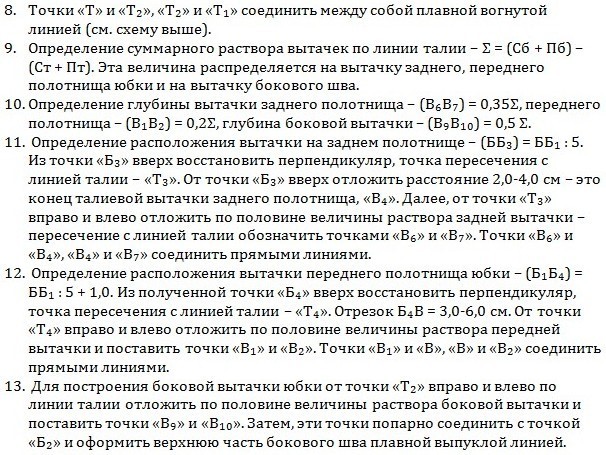
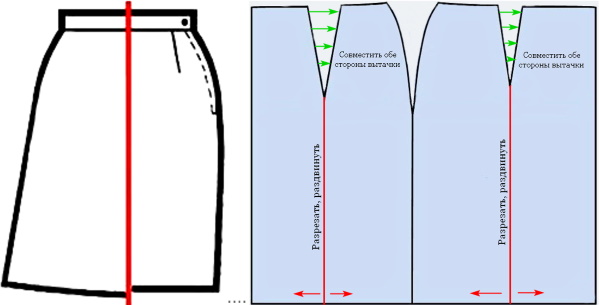
To create a trapezoid skirt, the patterns of a straight classic skirt should be cut into 4 parts (see the diagram above). Then, having aligned the sides of the darts in pairs, open and spread the skirt along the bottom. You can create additional volume for the product by adding 3.0-10.0 cm on both sides of the side seam along the bottom.
The pattern layout can be done in the opposite direction. However, then you need to take into account the placement of the pattern or shade of the fabric.
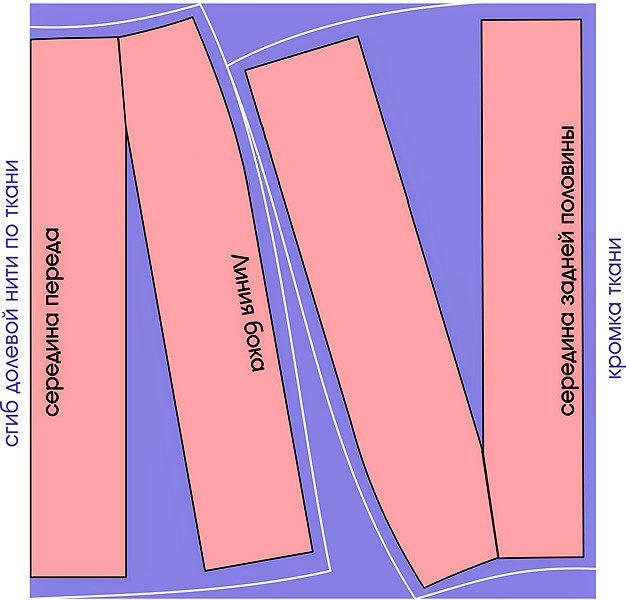
The flare of the skirt should be designed with smooth curved lines along all seams of the product.
Textile
A-line skirts are made from absolutely any material. The choice of material depends on the season, the desired image, the purpose and the woman's personal preference.
Denim
Denim items rarely remain unclaimed in a wardrobe, and denim skirts even more so. This is a practical and especially popular item among women of any age and body type. Denim trapezoid skirts of any length can be used all seasons as casual or work wear.
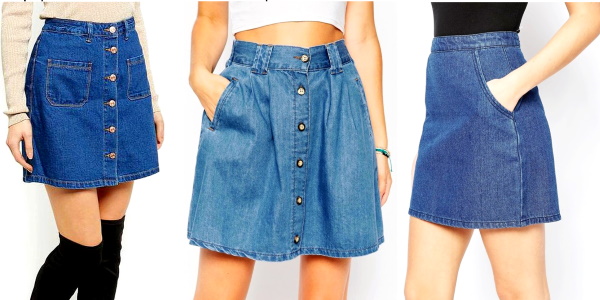
They go with any top and almost any footwear, from simple beach flip-flops to long leather over-the-knee boots or ankle boots with a wide shaft.
Leather
The A-line skirt (the pattern above is also suitable for leather) can be sewn from a genuine leather sheet, from high-quality elastic leatherette, eco-leather or suede. Leather products have always been considered a special luxury item, due to the characteristics of the material, its plasticity and high aesthetic qualities.
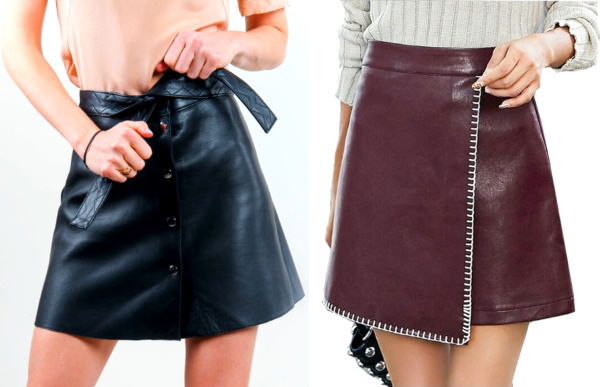
The leather A-line skirt fits the figure perfectly at the waist and upper thighs, and the flare at the bottom creates beautiful folds and hides all the flaws of the figure.
Knitted
Most women of all ages love A-line knitted skirts. They are comfortable, fit the figure perfectly and are very practical. Skirts made of thin or thick (voluminous) knitwear are all-season. They go well with light blouses and T-shirts, as well as warm sweaters and turtlenecks.
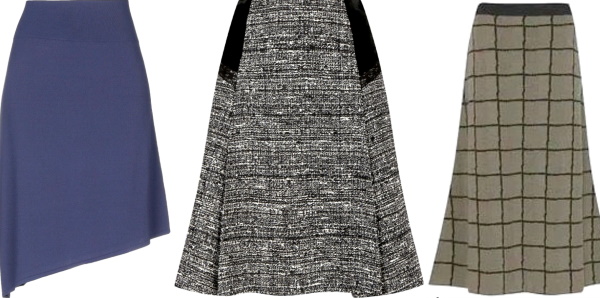
Depending on the style, knitted A-line skirts are worn with shoes with solid soles, sandals, open sandals, ballet flats, high-heeled shoes, and in winter – with high boots, half boots, ankle boots or dutik boots.
Silk
Silk A-line skirts are preferred by romantic natures. Light, playful models in the mini version are preferable for young girls. The fabric property suggests the use of numerous folds, flounces or ruffles. Silk skirts in the midi and maxi versions fit perfectly into the summer wardrobe of older ladies.
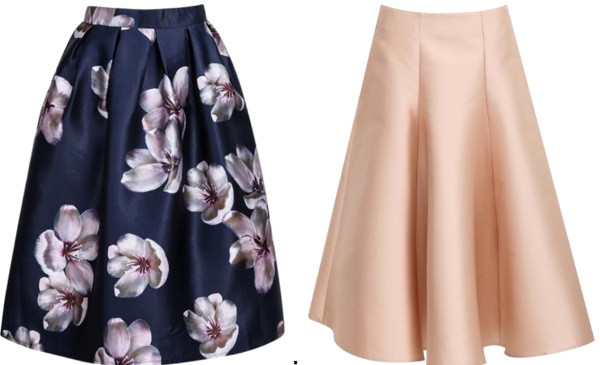
Silk A-line skirts are paired with simple T-shirts, blouses, and light cotton turtlenecks.
Chiffon
Flying, spectacular chiffon skirts give a woman a special mood. They are perfect for creating a mysterious, romantic image. Chiffon skirts "Trapeze" are made with a bias cut, multi-layered, with abundant gathers and flounces.
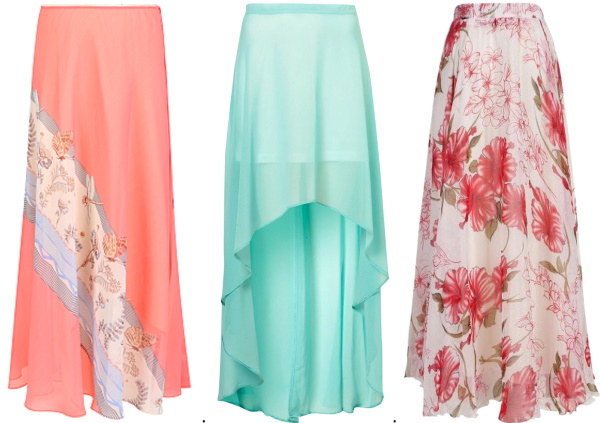
Stylish sandals or high-heeled pumps will go well with an image with an airy chiffon skirt.
Length
The A-line skirt (the model pattern is presented above) is good in any length. Slender, slender girls and young women can afford any length of the skirt - in any version, the skirt will look great on such a figure. For women of average build and full, the length below the knee and the skirt to the floor will be suitable.
Short
The mini skirt is suitable for girls, teenagers and young women with beautiful slender legs and narrow hips. The A-silhouette visually enlarges the hip area, and models with yokes, folds, gathers at the waist or from the hip completely hide this flaw.

For short A-line skirts, we recommend poplin, silk, chiffon, wool or suit fabric, leather, suede.
Midi
A midi skirt is a universal wardrobe item for any woman. This model does not cover the figure completely, which means that it will not look too bulky on a full figure.

At the same time, the skirt fits tightly to the waist and, due to its flare towards the bottom, hides the extra volume of the hips and legs. Well-chosen top, shoes and accessories make the image very feminine and stylish.
Long
The long A-line skirt is a more festive, evening version of the product, which will add elegance, femininity and romanticism to your look.
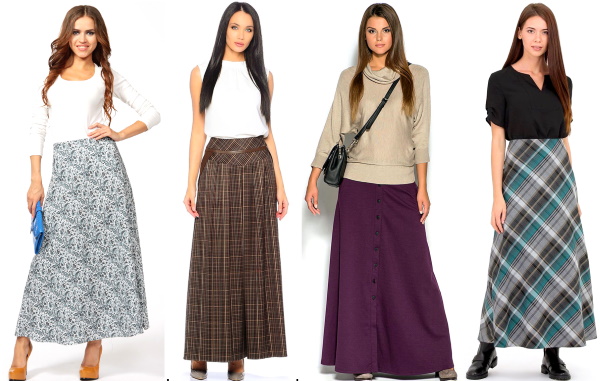
This outfit is more suitable for tall women, as the long floor-length skirt visually shortens the height and increases the figure in the hip area.
On an elastic band
A-line skirt (pattern of the model with elastic band is given below) is a comfortable and beautiful thing at the same time, which can be sewn with your own hands, even without having special sewing skills. Such skirts can be of different lengths. Short skirts with elastic band are suitable for girls, teenagers and young girls. Midi and maxi skirts are very popular with older women.
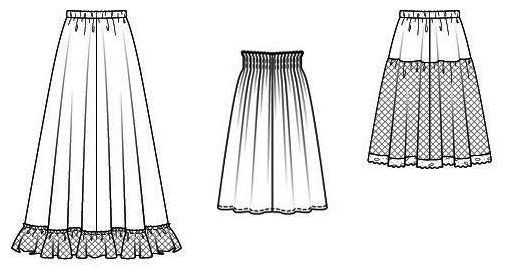
To construct a pattern for a skirt with an elastic band, you will need all the same patterns for the basics of a classic straight skirt. Then, as a result of modeling on paper or directly on fabric, the skirt is cut out taking into account the necessary seam allowances.
The construction of a pattern for a trapezoidal skirt with elastic is done as follows:
- Cut the patterns for the base of the straight skirt along the vertical lines dropped from the ends of the darts on the front and back halves of the skirt.
- Place the obtained base parts on a large piece of paper or fabric. First, match the darts of both halves in pairs, and then move the patterns apart to the required assembly size.
- Trace the patterns and design the waistline, bottom and side seam with smooth curved lines.
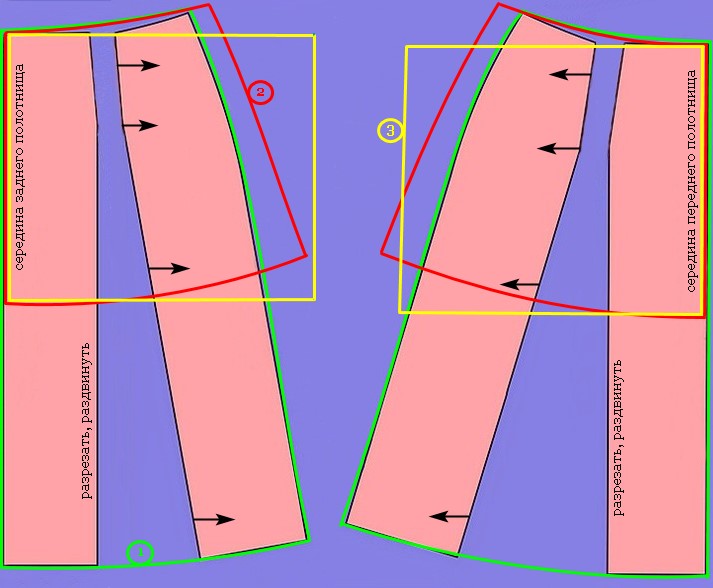
For a midi skirt (pattern #1) with moderate volume for elastic, the pattern spread can be from 5.0 to 12.0 cm. For a mini skirt (pattern #2) with medium volume of gathers for elastic, this value can be increased by additional spreading of the side seam (≈ 20.0 cm in total).
A short skirt with an elastic band and a large volume at the waist (pattern No. 3) can be cut out as a straight piece and with one connecting seam at the back.
The A-line skirt with elastic has the following technological sewing sequence:
- Place the skirt pattern on the fabric, taking into account the direction of the main thread, the fold point and seam allowances.
- Make a chalk mark for the skirt pieces and allowances for seam processing – 1.0 cm along the waistline, 1.5 cm along the side seam, 2.5 cm along the bottom of the skirt. Cut out the skirt pieces.
- Pin the paired side cuts together, stitch, overlock the cuts and iron towards the back.
- Pin a folded belt to the top edge of the skirt. After specifying its length at the top, sew the short sides and stitch the belt, leaving a small opening (1.0-1.5 cm) for threading the elastic. The belt under the elastic can be made narrow or wide (on several rows of elastic tape). Decorative wide elastic bands are used to finish the top seam in such skirts. A skirt with an elastic band can be sewn without a sewn-on belt. When sewing lightweight natural silk, chiffon or organza, sewing rubber threads are used as an elastic band.
- Insert an elastic band into the belt and secure the ends.
- Process the edge where the belt is attached with an overlock.
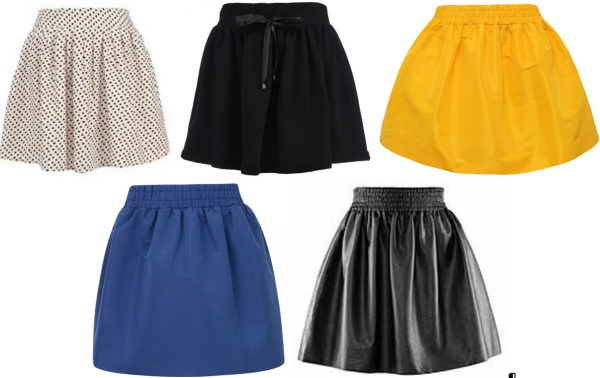
- Finish the bottom of the skirt with a hem stitch with an open or closed edge.
With buttons
An interesting idea in the design of the A-line skirt was the use of a button fastener. In this case, buttons are not only necessary fittings for fastening, but also an element of decorative trim of the skirt. The button fastener can be located in the front, on the side or on the back.
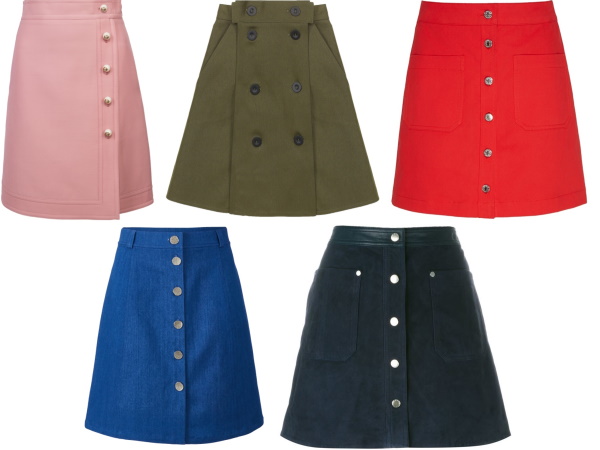
A modern print has become the use of large buttons of a contrasting color on mini skirts made of suiting fabrics and vice versa - small fittings in 1 or 2 rows in the main tone of the material.
With smell
An interesting trend of the last season was the wrap-around "Trapeze" skirt. Buttons, wide "bow" belts, all kinds of buckles or brooches are used as retaining fittings in such products. The piquant feature of the wrap-around model is the beveled upper half of the skirt and the bottom with a corner.
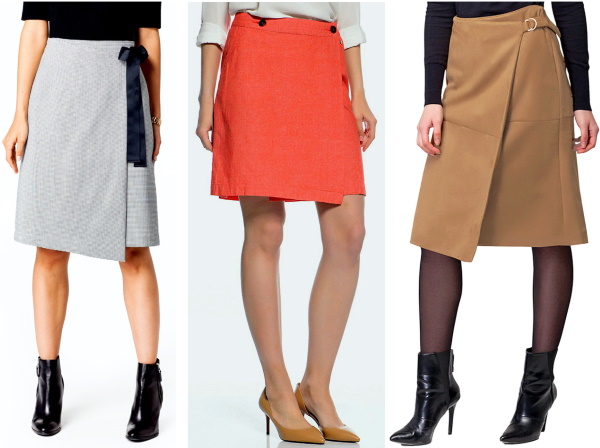
Skirts made of thick suiting or woolen fabric are decorated with contrasting trim along the wrap, gold or silver decorative buttons and braid.
In a fold
The model of the "Trapeze" skirt with pleats - deep, textured or small, "pleated" - always remains in demand. Pleated skirts are suitable for creating a romantic image and a business suit.
Skirts made of thick, suiting fabrics are sewn for work or study, for example, for schoolgirls in the "fall-winter" period. Fluffy and light skirts for summer are sewn from airy fabrics - silk, chiffon, organza or satin.
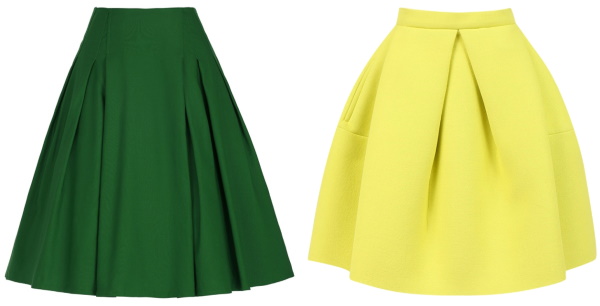
For many years, the A-line skirt has been a favorite model of women. Based on the classic straight skirt (the construction of the pattern is presented above), you can create a whole family of A-line skirts with your own hands. The shape of the skirt is suitable for creating an image of any style, for any season and for all categories of women.
Author: Severyanochka
Video about A-line skirt
How to sew a trapeze skirt without a pattern:
